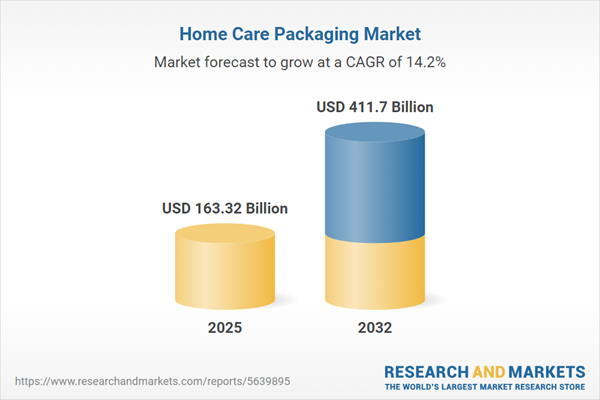Speak directly to the analyst to clarify any post sales queries you may have.
The home care packaging market is evolving rapidly as new consumer priorities, regulations, and innovations shape sourcing, design, and sustainability strategies across the industry. Senior leaders seeking actionable direction on navigating this change must understand the shifting interplay of market forces, supply chain adaptation, and emerging technologies.
Market Snapshot: Home Care Packaging Market Overview
The Home Care Packaging Market grew from USD 142.67 billion in 2024 to USD 163.32 billion in 2025. With a projected CAGR of 14.16%, it is expected to reach USD 411.70 billion by 2032. This growth is propelled by rising sustainability demands, regulatory shift toward eco-conscious standards, and the acceleration of e-commerce platforms requiring innovative packaging solutions. The market landscape is marked by increased collaboration between brands and material scientists, resulting in enhanced packaging performance and environmental stewardship.
Scope & Segmentation: In-Depth Market Coverage
- Product Types: Glass bottles, PET bottles, plastic bottles, pump dispensers, spray dispensers, HDPE jars, plastic jars, flat pouches, stand-up pouches, multi-compartment sachets, and single-compartment sachets.
- Material Types: Composite materials, LDPE and LLDPE flexible plastics, borosilicate and soda-lime glass, aluminum, steel, HDPE, PET, and PP plastics.
- Distribution Channels: Convenience stores, specialty stores, company websites, e-commerce platforms, supermarkets, and hypermarkets.
- End Users: Commercial (corporates, hotels), institutional (educational institutes, hospitals), and residential consumers.
- Regional Coverage: North America (United States, Canada, Mexico), Latin America (Brazil, Argentina, Chile, Colombia, Peru), Europe (United Kingdom, Germany, France, Russia, Italy, Spain, Netherlands, Sweden, Poland, Switzerland), Middle East (United Arab Emirates, Saudi Arabia, Qatar, Turkey, Israel), Africa (South Africa, Nigeria, Egypt, Kenya), and Asia-Pacific (China, India, Japan, Australia, South Korea, Indonesia, Thailand, Malaysia, Singapore, Taiwan).
- Industry Participants: Leading companies featured include Amcor PLC, Berry Global Inc., DS Smith PLC, Chemco Group, Clearpack, Constantia Flexibles GmbH, AptarGroup Inc., Graham Packaging, Jupiter Laminators Pvt. Ltd., and WestRock Company.
Key Takeaways: Strategic Insights for Decision-Makers
- Sustainability initiatives are transforming packaging development, driving the adoption of recyclable, biodegradable, and reusable formats as businesses respond to regulatory and consumer demands.
- Innovative materials and digital integration, including smart packaging with QR codes, NFC tags, and tamper-evident features, are critical for brand transparency, enhanced traceability, and improved consumer engagement.
- Expansion of e-commerce channels increases the focus on packaging durability and dimensional optimization to ensure product integrity in transit and reduce environmental impact.
- Global supply chain vulnerabilities and logistical disruptions are prompting companies to diversify sourcing, establish regional supplier partnerships, and invest in onshoring capabilities for greater agility.
- Strategic collaboration between R&D, procurement, and design teams accelerates the commercialization of advanced packaging solutions, supporting both compliance and competitive differentiation.
- Regional adaptation—particularly in emerging markets and regulated economies—remains vital, with tailored approaches benefiting from local manufacturing and evolving regulatory standards.
Tariff Impact: Responding to U.S. Trade Adjustments
Revised United States tariffs in 2025 have reshaped cost structures for manufacturers relying on imported polymers, glass, and metallic closures. The market response includes qualifying domestic production lines, expanding supplier bases geographically, and negotiating contracts with flexible pricing to manage volatility. Leaders are now prioritizing proprietary materials development and cross-functional R&D collaboration to offset cost increases and reinforce supply chain resilience.
Methodology & Data Sources
The research employs comprehensive secondary analysis of industry publications, regulatory filings, and public financial reports, alongside targeted primary interviews with senior executives, engineers, and sourcing specialists. All insights are validated through cross-verification and a rigorous quality control process, ensuring accurate, actionable guidance for strategic decision-making.
Why This Report Matters
- Enables senior executives to anticipate regulatory, technology, and sourcing trends that define new growth avenues in home care packaging.
- Offers granular segmentation and detailed regional perspectives, supporting targeted investment and product development strategies.
- Equips operations and supply leaders with frameworks for mitigating tariff exposure and enhancing supply chain flexibility.
Conclusion
This analysis empowers decision-makers to align product innovation, operational agility, and sustainability for long-term advantage in the evolving home care packaging market. Cross-disciplinary collaboration and regional adaptation will be essential for capitalizing on the next phase of industry transformation.
Additional Product Information:
- Purchase of this report includes 1 year online access with quarterly updates.
- This report can be updated on request. Please contact our Customer Experience team using the Ask a Question widget on our website.
Table of Contents
3. Executive Summary
4. Market Overview
7. Cumulative Impact of Artificial Intelligence 2025
Companies Mentioned
The companies profiled in this Home Care Packaging market report include:- Amcor PLC
- Berry Global Inc.
- DS Smith PLC
- Chemco Group
- Clearpack
- Constantia Flexibles GmbH
- AptarGroup, Inc.
- Graham Packaging
- Jupiter Laminators Pvt. Ltd.
- WestRock Company
Table Information
| Report Attribute | Details |
|---|---|
| No. of Pages | 192 |
| Published | November 2025 |
| Forecast Period | 2025 - 2032 |
| Estimated Market Value ( USD | $ 163.32 Billion |
| Forecasted Market Value ( USD | $ 411.7 Billion |
| Compound Annual Growth Rate | 14.1% |
| Regions Covered | Global |
| No. of Companies Mentioned | 11 |









